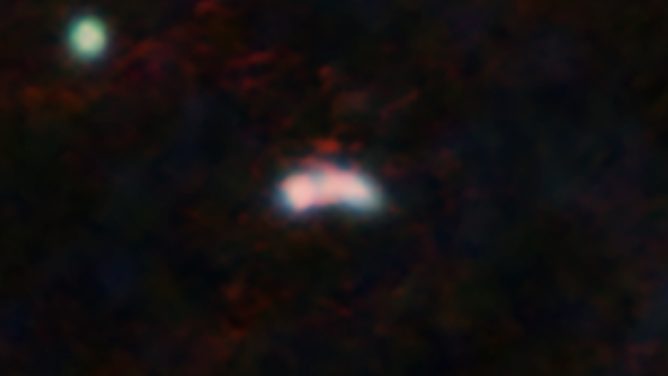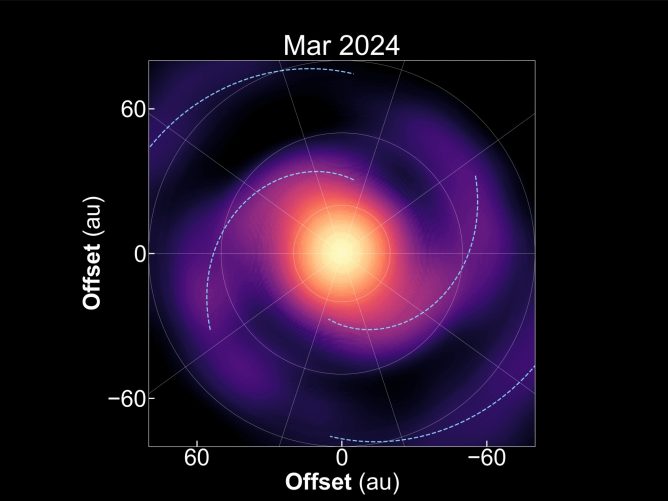At the centre of our galaxy lurks a cosmic monster: a supermassive black hole called Sagittarius A* with a mass about four million times that of the Sun. Its gravity is so intense that not even light can escape its pull, but if it wasn’t for its strong gravitational influence on the stars and gas around it, we would have no idea that it was there! Now, an ambitious new endeavour is underway to take a never-seen-before image, of the event horizon of the black hole itself.
Two international collaborations of radio telescopes have linked up to create Earth-sized virtual telescopes: the Event Horizon Telescope (EHT) and the Global mm-VLBI Array (GMVA), working at different wavelengths. The impressive line-up of telescopes, which stretch across the globe from the South Pole to Hawaii to Europe, will work together to target the supermassive black hole at the heart of the Milky Way.
To do this, astronomers will exploit a technique known as Very-long-baseline Interferometry (VLBI), where telescopes thousands of kilometres apart can link together and act as one. This cooperative technique can achieve a far higher resolution than any single facility could obtain on its own—a resolution 2000 times that of the NASA/ESA Hubble Space Telescope! This super-high resolution is crucial for detecting the black hole, which—despite being about 20 times bigger than the Sun—lies a long way away, over 26 000 light-years from Earth.
The plan to image a black hole has been in the works for years, but it’s only recently that technology has brought the ambitious endeavour within reach. Plus, a radio telescope heavyweight has just joined the team: the Atacama Large Millimeter/submillimeter Array (ALMA).
Located high up on the Chajnantor plateau in Chile’s Atacama Desert, ALMA’s 66 antennas and exquisite receivers make it the largest and most sensitive component of the EHT/GMVA collaboration, increasing the overall sensitivity by a factor of 10. Despite being a state-of-the-art facility, ALMA has undergone several upgrades to take part in the collaboration. Specialist equipment has been installed, including new hard drives that are necessary to store the sheer amount of data produced by the observations, as well as an extremely accurate atomic clock, which is critical to link ALMA to the entire VLBI network.
The first groundbreaking observations will be made in April 2017: observations at 3 millimetre wavelengths will be made with the GMVA from 1-4 April 2017, and with the EHT at 1.3 millimetre wavelengths from 5-14 April 2017. The GMVA will investigate the properties of the accretion and outflow around the Galactic Centre, while the EHT will attempt to image, for the very first time, the shadow of the black hole’s event horizon.
There is a long, hard road ahead to process the massive amounts of data that will be acquired during the observation periods, and results are expected to become available towards the end of 2017.
The outcome of these observations is eagerly awaited by the astronomy community worldwide, as their scientific potential is incredibly exciting and the collaboration are pursuing some awesome goals. These could include testing Einstein’s theory of general relativity, which predicts a roughly circular “shadow” around the black hole. Other goals include learning about how material accretes around black holes, as well as the formation of extremely fast jets of gas that blast out from them.
This is the first post of a blog series that will take you along for the astronomical ride, giving insight into how cutting-edge research is done and what risks are involved.
In the following posts, we’ll explore questions such as: What makes black holes so interesting? How do radio telescopes see the Universe? And what do we really know about the supermassive monster lurking at the centre of the Milky Way?
Below: simulated images of the shadow of a black hole: General relativity predicts that the shadow should be circular (middle), but a black hole could potentially also have a prolate (left) or oblate (right) shadow. Future EHT images will test this prediction.
Credit: D. Psaltis and A. Broderick










